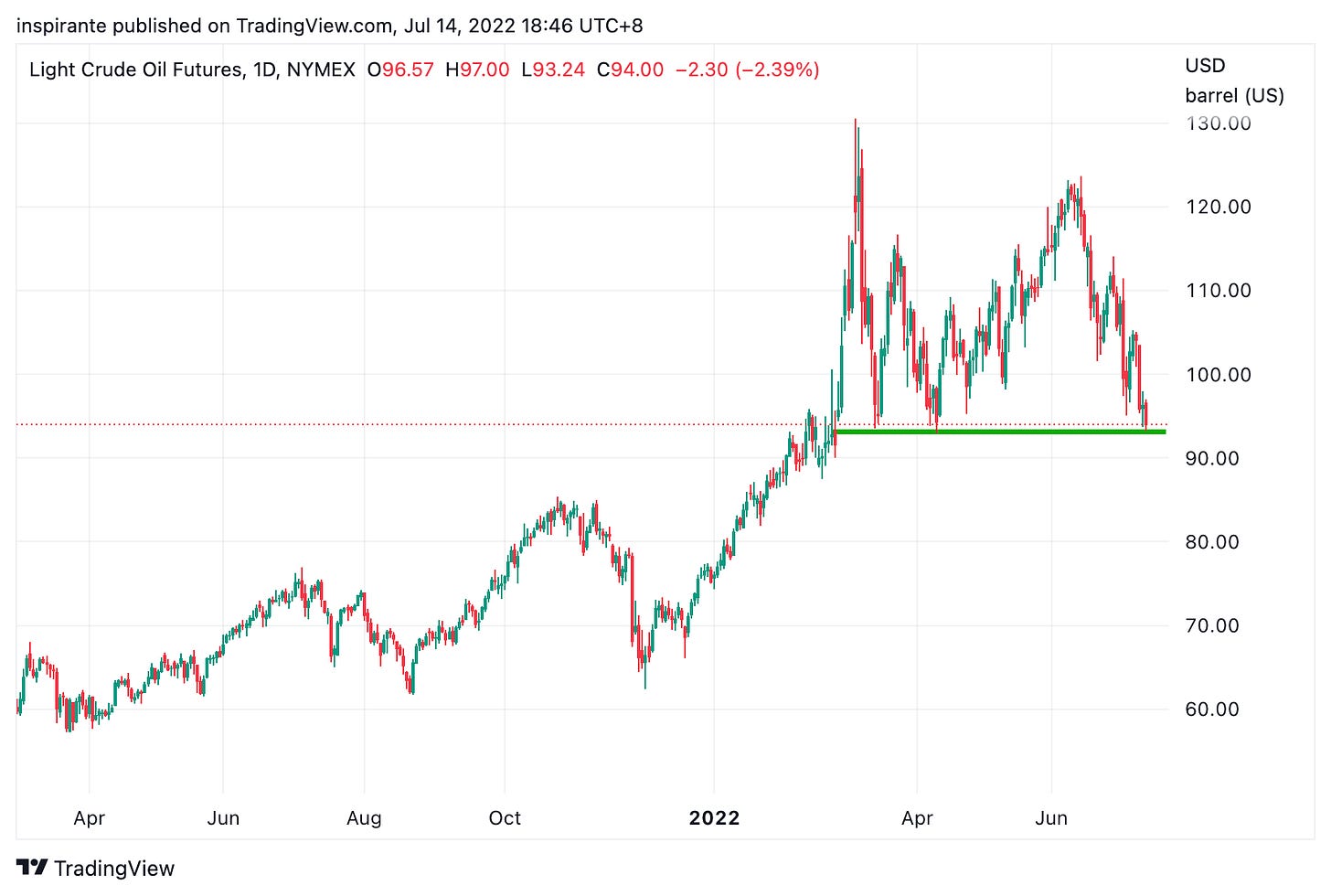Markets in Focus
Some people have been calling the rapid strengthening of the greenback the USD Wrecking Ball. How prescient! The US Dollar Index smashed through 104 and reached above 108, the highest level in 20 years. It is a broad strengthening against most other currencies, from the Euro and the Yen to many Emerging Market currencies. Huge repercussions are being felt in the entire financial market.
Wheat was one of the most prominent commodities affected by the Russia-Ukraine conflict, as these two countries are among the world’s top wheat producers and exporters. However, since early May, the wheat price sharply reversed. After breaking the neckline of the Head-and-Shoulder top, it continued to drop like a stone, now giving back the entire gain post-Russian invasion. It is finding some support at the 14-month trendline.
Soybean also has erased the entire gain of 2022 in a matter of a few weeks. When the 1400 level was broken, it gapped down immediately to further drop to 1300, which is another significant support.
Crude oil has given back its entire gain since the geopolitical conflict started. It is currently trading around a significant support level of 93, which has turned back the decline multiple times this year. It is crucial to see if the support holds this time.
After a sharp decline of more than 40% from the high of 9.5 to the low of 5.5, natural gas seems to have completed an inverse Head-and-Shoulder bottom. If it manages to break above 7.0, we should see much further rally to ensue.
Market Views
The US June CPI data beat consensus again, accelerating to 9.1%. Global central banks are resolutely hawkish in fighting inflation that does not seem to peak soon. Large rate hikes, shrinking balance sheets, and draining liquidity from the system have undeniably created the demand-destruction effect, such that the debate of the market has now become when, not if, the recession will hit. The aggressive tightening is like the Hulk of the Avengers, smashing everything in front of him, from the “puny god” Loki to the great Chitauri army.
There is an old Wall Street adage saying that “the market takes the stairs up and the elevator down.” Over the past few weeks, we have witnessed the substantial decline of many financial assets. The Nasdaq index lost 34% in half a year, with many high-flying names dropping more than 70% from the recent highs. The Euro and the Yen weakened by 18% and 26% against the US Dollar since 2021, respectively. Many Emerging Market currencies, such as the Chilean Peso and the Sri Lankan Rupee, are eviscerated because of the perfect storm created by the strong US Dollar and high energy and food prices, wreaking havoc on these debt-laden countries.
Commodity investors felt the most pain, just as more and more people started to believe the super-cycle was finally here. The reversals, especially of industrial metals and agriculture commodities, have been nothing short of jaw-dropping. Copper plunged 37% since March. Lumber lost more than 60% from the high. Wheat has one of the deepest declines among grains. At nearly 40% below the high, it has completely given back the gains since the Russia-Ukraine conflict broke out. Indeed, everything from equities to bonds, currencies, and commodities have all been smashed hard.
Amid the widespread pessimism, the recession fear, the forced de-grossing, and the headline-driven FOMO buying been largely cleared, we find the opportunity to own agriculture and energy commodities a lot more attractive from a risk/reward perspective than a few months ago. Take wheat, for example; although the export situation in Ukraine is improving, the readers should ponder how much lower the price can go, given it is already trading at levels before the invasion, against the backdrop of a severe global food and energy shortage, and countries banning fertilizer exports as the price went through the roof. We cannot help but be reminded of Warren Buffett’s famous quote, “Be fearful when others are greedy, and greedy when others are fearful.”
How to play the theme out
A hypothetical investor can consider the following trades1:
Case Study 1: Long Chicago SRW Wheat Future
If the investor were to long the Chicago SRW Wheat future (ZWZ2) at 819 and set the stop below 700, his maximum loss per contract would be (819 – 700) x 50 = 5950 USD. An initial target points to 1050 and subsequently 1300, resulting in (1050 – 819) x 50 = 11550 USD and (1350 – 819) x 50 = 26550 USD.
Case Study 2: Long Henry Hub Natural Gas Future
If the investor were to long the Henry Hub Natural Gas future (NGQ2) at 6.76 and set the stop below 5.90, his maximum loss per contract would be (6.76 – 5.90) x 10000 = 8600 USD. An initial target points to 8.20 and subsequently 9.60, resulting in (8.20 – 6.76) x 10000 = 14400 USD and (9.60 – 6.76) x 10000 = 28400 USD.
Original Link: https://www.cmegroup.com/newsletters/fresh-from-the-trading-room/files/fresh-from-the-trading-room-2022-07-15.pdf
Examples cited above are for illustration only and shall not be construed as investment recommendations or advice. They serve as an integral part of a case study to demonstrate fundamental concepts in risk management under given market scenarios.









